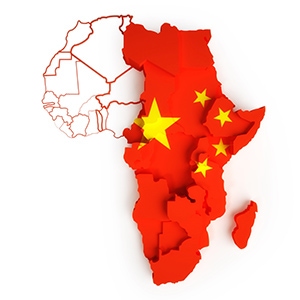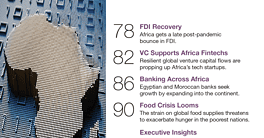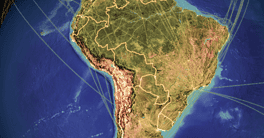Chinese finance is stepping up in Africa. While other powers worry about Beijing’s growing influence, it’s hard for cash-strapped governments to say no.

Africa is the world’s largest recipient of foreign direct investment (FDI)—and, arguably, the one most in need. The continent will have to invest an additional $2 trillion by 2040 if it is to meet the needs of its expanding population, according to Global Infrastructure Hub, a Group of Twenty (G20) initiative. Yet, the inflow of cash has scaled down. In 2017, sub-Saharan Africa received $28.5 billion in FDI, a 28% decrease from 2016.
Enter China. In those same years, the value of Chinese civil infrastructure loans to African countries almost tripled, from $3 billion to $8.8 billion. Lenders are mostly public banks, including the Export-Import Bank of China (Exim), the China Development Bank, Bank of China, and the Industrial and Commercial Bank of China. According to a recent study by Baker McKenzie and IJGlobal, by 2017 Chinese lenders accounted for more than 40% of all infrastructure finance in sub-Saharan Africa, the bulk of it going to transportation and energy projects.
Not everyone is happy about it. The U.S. and other major countries are concerned about rising Chinese political influence stemming from its investments on the continent. Even some in Africa itself worry that their governments are digging themselves into a debt trap with Beijing and Chinese lenders and could lose control of major national assets. These concerns are likely to grow as Chinese influence deepens.
What’s undeniable, however, is that sub-Saharan Africa suffers from a drastic lack of infrastructure. Basic services such as transportation and electricity are sporadically available to most people (if at all)—a major obstacle to economic development. Bridging the continent’s infrastructure gap alone would cost around $90 billion per year, according to the World Bank. That’s doable but risky, for most investors, since infrastructure financing means big-ticket, long-term commitments with little guarantee of profitability in volatile environments.
In a world where most lenders are risk averse, China not only offers competitive loans but can also be an easy partner to deal with. “The negotiations and conditions to get a project approved are easier,” says Kieran Whyte, head of Energy, Mining and Infrastructure at Baker McKenzie’s Johannesburg office. “The Chinese are open to discussions with countries whose financial constraints wouldn’t allow them to find funds on traditional markets.”
What if African borrowers aren’t able to secure a sufficient revenue stream to pay back the debt? The Chinese will accept collateral. “The payment obligation comes in the form of resources,” says Whyte. “If the borrowing countries have something that China wants, then that will offset some of the risk.” Angola, for example, uses its crude oil as collateral.
There are concerns, however, that this might hinder some countries’ development in the future, since revenue streams from some of the region’s most valuable resources will flow overseas instead of into workers’ pockets and local development. Chinese lenders themselves have their critics, as they don’t always respect international environmental, social and employment practices. In Kenya, for example, Chinese companies have faced waves of protest, including rail-worker strikes in 2016 overpay and working conditions.
For China, investing in Africa comes with a long list of advantages: an opportunity to secure resources and establish a foothold in fast-growing new markets, and a chance to place some of the country’s large foreign-exchange reserves in infrastructure investments that offer higher returns than U.S. government debt. China also sees an opportunity to take its companies abroad.
“Part of China’s strategy is to have Chinese companies carry out at least part of the projects and thereby gain international exposure,” says Georges Sioufi, a lawyer at SRDB Law Firm, which represents the interests of the Chinese Jingsh law firm in France, Africa and the Middle East North Africa (MENA) region. “It is a way to widen China’s sphere of influence in the world.”
Today, over 10,000 Chinese firms are involved in Africa. When it comes to civil construction, they boast strong know-how— much needed in a developing continent. Their domestic expertise, especially in the rail, power and energy sectors, combined with cost-effective China-made equipment, give them a comparative advantage. When that isn’t enough, Chinese banks offer an extra push. “When needed, Chinese banks provide financing to help Chinese companies win the tenders,” says Simon Leung, partner in Baker McKenzie’s Hong Kong office.
Infrastructure financing in Africa is part of the Chinese government’s international projection of economic power. Most projects fall under the Belt and Road Initiative, a $350 billion global project launched in 2013 by President Xi Jinping that aims to make the entire Eurasian continent commercially accessible to China.
In Africa, this includes over 3,000 projects spread over 35 countries. Kenya and Nigeria were the earliest recipients of Chinese money, accounting for almost 40% of all loans since 2014. Others include Tanzania, Zambia, Djibouti, Ethiopia and Senegal. [See table at the right for a short list of big deals.] When completed, projects like these can be game changers for the recipient countries, providing foundations upon which local economic activity can develop and giving landlocked countries access to international trading routes.
The demand is huge, and China is competing directly with other countries, including the U.S.’s Power Africa program. Even China can’t do it all alone, however. An important portion of its African infrastructure financing goes through public-private partnerships and hybrid deals, offering other investors—as well as other governments, private-equity funds and international institutions—a chance to jump in. The government is making regulatory adjustments to further encourage these partnerships. For instance, to get a loan facility covered by Sinosure, the Chinese export credit agency, it is no longer required that Chinese lenders take up a majority stake. An increasing number of Chinese banks are also taking part in syndicated loans with Western banks such as Standard Chartered and Deutsche Bank.
“We believe this is a welcoming sign,” says Leung, “showing that Chinese lenders are getting more and more comfortable adopting internationally recognized standards to grant and manage the loans, including more comprehensive due diligence and credit risk assessment and more relevant documentation and security.”
Africa’s financing needs are not only huge—and growing. The Chinese are here to stay. Perhaps the most significant indicator is investment by state-owned financial institutions and the Chinese government itself. In 2015, China paid $690 million to acquire a majority stake in South Africa-based Standard Bank, Africa’s largest bank by assets. In July of this year, Xi pledged to invest $14.7 billion on top of infrastructure loans to South Africa. Further pledges are expected from the Beijing-based New Development Bank, an alternative multilateral development bank set up by the Brazil, Russian, India,China or BRICS countries. As China’s web of investments, loans and commitments extends deeper into Africa the U.S., EU and other interested parties will be looking for ways to push back. Until they can make a better offer, however, Beijing’s role on the continent is unlikely to diminish.



